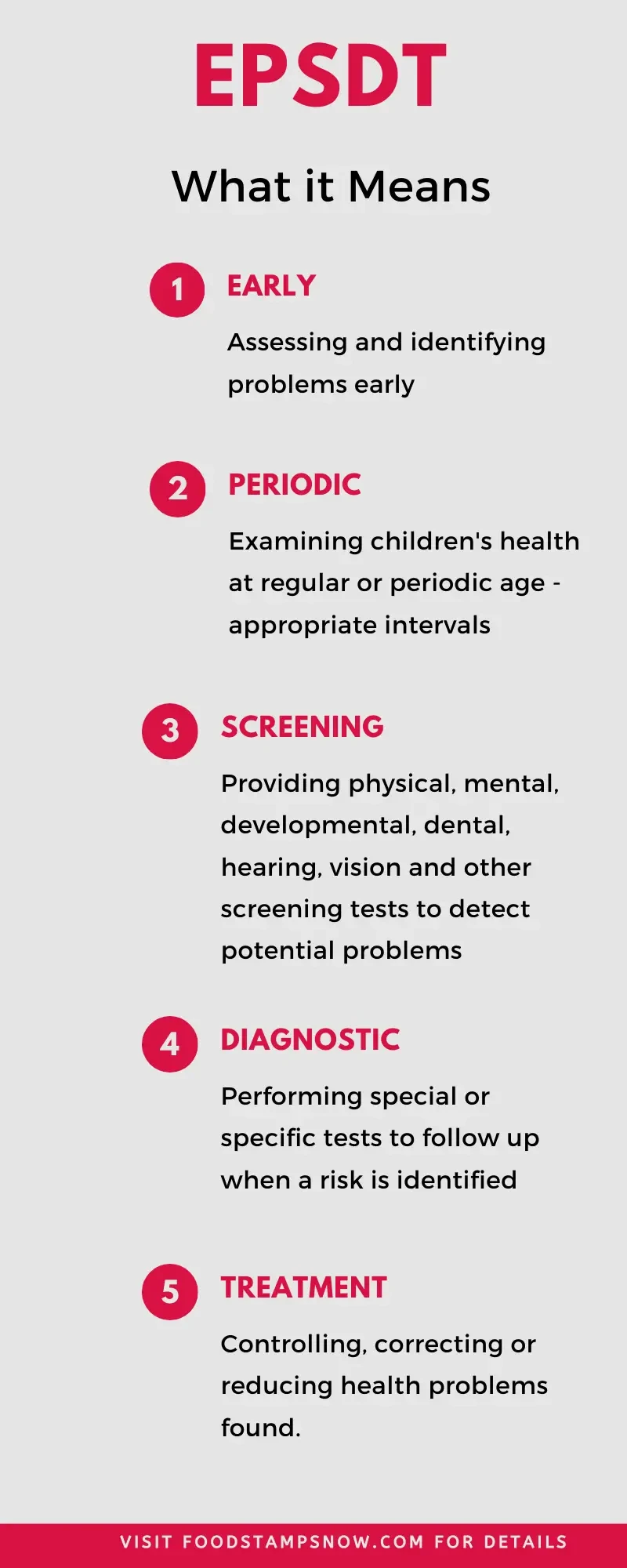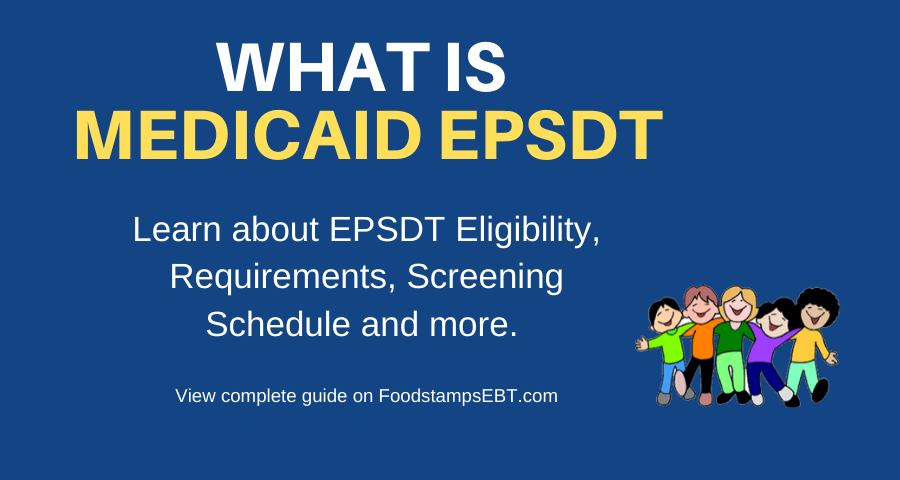Medicaid EPSDT is the most critical part of Medicaid for Children. Yet, many parents are not taking full advantage of the benefit, to the detriment of their children.
In this post, we are going to explain everything you, as a parent, need to know about the Medicaid EPSDT program.
After you are done reading this article, you should get a basic understanding of the program.
You will then be able to be an informed advocate for your child in getting him or her the EPSDT benefits they are eligible for.
This post about Medicaid EPSDT will cover:
- What is EPSDT?
- Who is Eligible for EPSDT?
- What are EPSDT Requirements?
- What is covered under EPSDT?
- Consequences when States Fail with EPSDT
- What Can You Do as a Parent of a Child?
- State by State EPSDT Information
- EPSDT FAQs

What is EPSDT?
EPSDT stands for Early and Periodic Screening, Diagnosis and Treatment.
EPSDT is a child health benefit under Medicaid. It is designed to help the physical, mental and developmental health needs of children.
EPSDT is key to ensuring that children and adolescents receive appropriate preventive, dental, mental health, and developmental, and specialty services.
Who is Eligible for EPSDT?
All children under age 21 enrolled in Medicaid are entitled to the Early and Periodic Screening, Diagnostic, and Treatment (EPSDT) benefit.
States are required by federal law to provide access to any Medicaid-coverable service in any amount that is medically necessary.
This is required, regardless of whether the service is covered in the state’s Medicaid plan.
What is the Purpose of EPSDT?
The purpose of EPSDT is to find and treat health problems early so that children can have the best health and development possible.
It is also meant to discover and treat childhood health conditions before they become serious or disabling.
States must inform all Medicaid-eligible families about the benefit, screen children at reasonable intervals, diagnose and treat any health problems found.
In addition, states are required to report certain data regarding EPSDT participation annually to the Centers for Medicare & Medicaid Services.
What are EPSDT Requirements?
Services must be ordered by the child’s physician or another licensed clinician. Prior approval from the state’s Medicaid agency may be required to verify medical necessity for some services.
Here are the covered services under EPSDT:
- Must be medically necessary to correct or ameliorate a defect, physical or mental illness or a condition that is identified through a screening examination
- Must be listed in section 1905(a) of the Social Security Act
- Must not be experimental/investigational, unsafe or considered ineffectivE
What is covered under EPSDT?
EPSDT screening services can be conducted by physicians, certified nurse practitioners or physician assistants and include the following:
Here are the required Services under EPSDT:
Screening – comprehensive unclothed exam and health/ developmental history,
appropriate immunizations (per Advisory Committee on Immunization Practices (ACIP) schedule) health education (including anticipatory guidance), includes lab (including blood lead)
• Vision Services – Including eyeglasses
• Dental Services – Including relief of pain and infections, restoration of teeth, and maintenance of dental health
• Hearing Services – Including hearing aids
• Such other necessary health care, diagnostic services, treatment, and other measures described in section 1905(a) to correct or ameliorate defects and physical and mental illnesses and conditions discovered by the screening services, whether or not such services are covered under the state plan.

How Many Children are Eligible for EPSDT?
In 2014, over 40 million children were eligible for EPSDT.
However, just under 60 percent of children who should have received at least one initial or periodic screening received one.
The State’s Responsibility to Families
It is the responsibility of your state to inform you of your EPSDT benefits.
Within 60 days of a child’s initial Medicaid eligibility determination, your state’s Medicaid Agency is supposed to inform you of the benefits of preventative healthcare under EPSDT.
In addition, every year after a child has been signed up for Medicaid, the state’s Medicaid agency has to inform all families that have not used EPSDT services about the benefits of preventive health care, the services available under EPSDT, and how to obtain them.
The state must also inform families that these services are available without cost except for enrollment fees or premiums that may be imposed on medically needy beneficiaries and that transportation and scheduling assistance are available.
Consequences when States Fail to Uphold the Medicaid EPSDT Mandate
Available data shows that states have not been diligent in meeting their obligations under the EPSDT program.
For example, according to this report by the Department of Health and Human Services, most Medicaid children in 9 states were not receiving the required preventive services.
While there are many areas where states have fallen short of EPSDT standard, dental care, lead screening, and mental health services are the three areas with the most severe consequences for children.
Failure in Dental Care
Where EPSDT Fails in Dental Care
A healthy mouth is essential to maintaining proper nutrition and the general well-being of a child. Unfortunately, dental care is one of the most common issues children face.
In 2014, only 48 percent of eligible children on Medicaid received preventive dental care and when a problem was identified, only 22 percent received treatment for that condition.
Failure to Screen for lead
Children exposed to lead may face serious health consequences ranging from anemia to behavioral and neurologic disorders.
EPSDT requires that children enrolled in Medicaid be screened for lead in their blood at 12 months and 24 months of age.
However, Medicaid data for 2015 shows that only 38 percent of children had been screened for blood lead levels as required by the EPSDT mandate.
Failure in Mental Health Services
Once a child between 6 and 20 years old has been hospitalized for a mental illness, access to continued behavioral and mental health services is essential.
EPSDT requires that these children be seen in follow-up within 7 days of their hospital discharge.
For 2014, on average, only 44 percent of children were seen in follow-up within 7 days and 65 percent within 30 days of hospitalization for mental illness.
What Can You Do as a Parent of a Child?
As you can see, the states are not meeting their obligations to Children under EPSDT.
Even though they are required to report performance data to the federal government, when states do not report their data or did not meet EPSDT standards, they are not penalized by the Centers for Medicare and Medicaid Services (CMS).
This means that the program is not going to get better because the federal government enforces its laws.
Your child is only going to get the care he or she deserves when you stand up for your child. You should read the EPSDT information on your state’s Medicaid website.
Then talk to your healthcare provider and make sure you are staying on top of the required screenings and tests.
You want to problems with your child’s health early so that they can be resolved before they get worse or become permanent issues.
In addition, over the years, families and children have gone to court to enforce the EPSDT requirements.
State by State EPSDT Information
The American Acadamy of Pediatrics (AAP) has recommendations regarding Preventative Pediatric.
It is included in this table (Bright Futures/AAP Recommendations for Preventive Pediatric Health Care (Periodicity Schedule) that shows what screening, testing and care a child needs from infancy to adolescence.
The AAP releases a report showing how each state’s Medicaid and EPSDT programs measure against the Bright Futures recommended standards.
Click below to see your state’s report:
EPSDT Questions
We hope this post on Medicaid EPSDT was helpful.
If your question was not answered and are still having trouble with EPSDT, please let us know in the comments section below.
Be sure to check out our other articles, including Amazon EBT Discount for Medicaid Cardholders.
